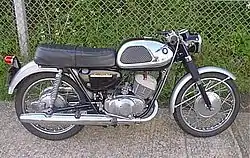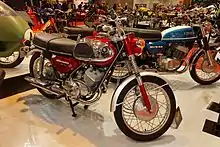Suzuki T20
The Suzuki T20 is a motorcycle with a 247 cc (15.1 cu in), two-stroke, twin-cylinder engine, and six speed gearbox. It was first manufactured in 1965 (but introduced as a 1966 model) and was produced until the end of the 1968 model year. Production peaked at more than 5000 units per month. It was superseded by an updated version which was designated the T250-1. An X6 is owned by comedian Jay Leno, and one segment of his web program called Jay Leno's Garage features his profile of the motorcycle.[1]
 | |
| Manufacturer | Suzuki |
|---|---|
| Also called | Suzuki X6 (US) Suzuki Super Six (UK) |
| Production | 1966-1968 |
| Predecessor | Suzuki T10 |
| Successor | Suzuki T250-1 |
| Engine | 247 cc (15.1 cu in) air-cooled two-stroke parallel twin |
| Bore / stroke | 54 mm × 54 mm (2.1 in × 2.1 in) |
| Top speed | 152 km/h (94 mph) |
| Power | 29 hp @ 7500 rpm |
| Transmission | 6-speed manual |
| Weight | 138 kg (304 lb) (dry) |
| Fuel capacity | 3.7 US gal. |
Marketing
In the UK the T20 was called the 'Super Six' (which refers to the motorcycle's very unusual six speed transmission, since most motorcycles had only four speeds or, rarely, five speeds) in that era. In the USA the bike was designated the X6 with the advertising department tacking on the "Hustler" name.[2]
Advertising brochures produced by Suzuki listed the following features to be found on the new model:
- Claimed power of 29 hp
- Claimed weight of 297 lb (135 kg)
- Racing type double leading shoe 8 inch front brake
- Aluminium alloy twin cylinder engine
- Close ratio 6-speed transmission
- Twin 24 mm carburettors
- POSI-FORCE lubrication
- Air pump
- Scientifically designed quiet efficient mufflers
- Safe powerful 8 inch rear brake
- Wide type tail lamp
- Safe bright turn signal lamps
- 3 position adjustable shock absorbers
- Wide, comfortable dual seat
- 3.7 US gal (14 litre) gasoline tank
- Racing type throttle
- Easy-to-read tachometer and speedometer
- Sturdy oil damped telescopic front fork
- 12 volt fully approved lighting system
In the US, Suzuki first opened a showroom featuring the X6 Hustler in Santa Monica, CA (in late 1964 or early 1965) and shortly after (in June 1965) opened a second showroom (the first on the US east coast), named Cycle City, located in Newport News, Virginia.
Posi-Force system

The T20 was equipped with a 247 cc two-stroke engine, which meant that oil needed to be mixed with gasoline prior to injection into the cylinder. Simple two-stroke designs simply achieved this by requiring the user to combine oil and gas together (a solution known as pre-mix) before filling the fuel tank. However, in an advanced system like the T20, which was expected to operate for longer periods at higher RPMs, this would have been unsuitable. An excess amount of oil would be burned using pre-mix under these conditions, resulting in reduced performance and dirtier emissions, which in turn would cause the exhaust system to become laden with deposits, further reducing performance.
The T20 solves this problem by incorporating a once-through oil injection system known as Posi-Force, which consists of an engine-driven oil pump coupled to the throttle, which is designed to provide the proper amount of oil needed at the current RPM and throttle opening. The pump draws clean oil from a separate oil tank, and pumps it through hoses into the crankcase, where it is injected into the engine outside main bearing(s) and big end rod bearings of the crankshaft. Suzuki improved upon the system by adding oil injection directly to the cylinders on newly introduced models starting in 1968 such as the T250, T305 and the T500. Suzuki would continue to use this system on many of their two-stroke motorcycle designs. Posi Force was renamed CCI (Crankcase-Cylinder-Injection) in the early 1970s and was used until the end of two stroke street bike production in the late 1990s.[2]
Racing

The T20 immediately had real success on the race course in the 1960s, and many are still used to this day in Classic Racing meetings around the world. The T20 has had notable success in the Manx Grand Prix and some riders have managed to lap the famous Isle of Man course at over 100 mph on heavily modified T20s.[3]
Revival
In 2013, Suzuki renewed the Hustler motorcycle trademark for Europe, leading to rumors of a retro style 250 twin in the works, or possibly a new sportbike.[4][5]
References
- "1966 Suzuki X6 Hustler". Jay Leno's Garage. NBC Studio, Inc. 10 April 2008. Retrieved 5 October 2013.
When Suzuki introduced the X6 in the fall of 1965, it caused an immediate sensation. Developed with the goal of captivating the U.S. market, the Hustler was designed to be the fastest 250 cc motorcycle in the world. The bike featured Suzuki's first ever tubular steel double-cradle frame, and its air-cooled two-stroke sleeved aluminum cylinder engine was capable of just about 100 mph. Surprisingly sophisticated, this little engine achieved 100 hp per one liter cylinder volume, which meant it could outrun most of the bigger, faster bikes on the road. It featured automatic oil injection, but more importantly, it was the first six speed motorcycle ever to go into full production.
- Steven L. Thompson (8 November 2010). "L+S=MF (Cont'd)". Cycle World (Blog). Bonnier Corp. Retrieved 5 October 2013.
In the September, 1966, issue of CW, Suzuki ran an ad for the X6 Hustler 250, a ferociously quick 250cc piston-port Twin with six speeds and “Posi-Force” oil injection. What made the ad stick in my mind all these years was the copywriter’s line at the top: 'We’ve invented a very fast way to lose 70 lbs.' The point being, as the body copy of the ad made clear, that the Suzuki was as quick and fast as most 500s but it weighed much less.
- "Suzuki Motorcycles - The GS Papers - From GS To GSX-R". Motorcyclist Magazine. 1 April 2007. Retrieved 5 October 2013.
In the mid-'60s came a breakthrough bike: the T20, known in the U.S. as the X6 Hustler. Packing a 247cc two-stroke twin with an industry-first six-speed transmission, dependable 12-volt electrical system, double-leading-shoe front brake and adjustable shocks, the performance-oriented Hustler became a big seller in several countries and did well in racing, even scoring victories at the Isle of Man. Small, lightweight and fast, the X6 was a window on the future for Suzuki.
- "Suzuki to revive Hustler name". Visordown. Immediate Media Company Ltd. 25 January 2013. Retrieved 7 October 2013.
We can be pretty certain that whatever the new machine turns out to be, it won’t follow the mechanical pattern of the original Hustlers, which were 250cc two-stroke parallel twins. Suzuki’s new 250cc four-stroke twin, as used in the naked Inazuma, might be a good choice.
- Beresford, Jack (29 January 2013). "Suzuki plotting return of the Hustler motorbike?". MotorbikeTimes.com. Retrieved 7 October 2013.
Whatever the case, reports indicate that the update could be heavily influenced by the classic T20 and T250 Hustlers which became such an iconic part of the brand itself.